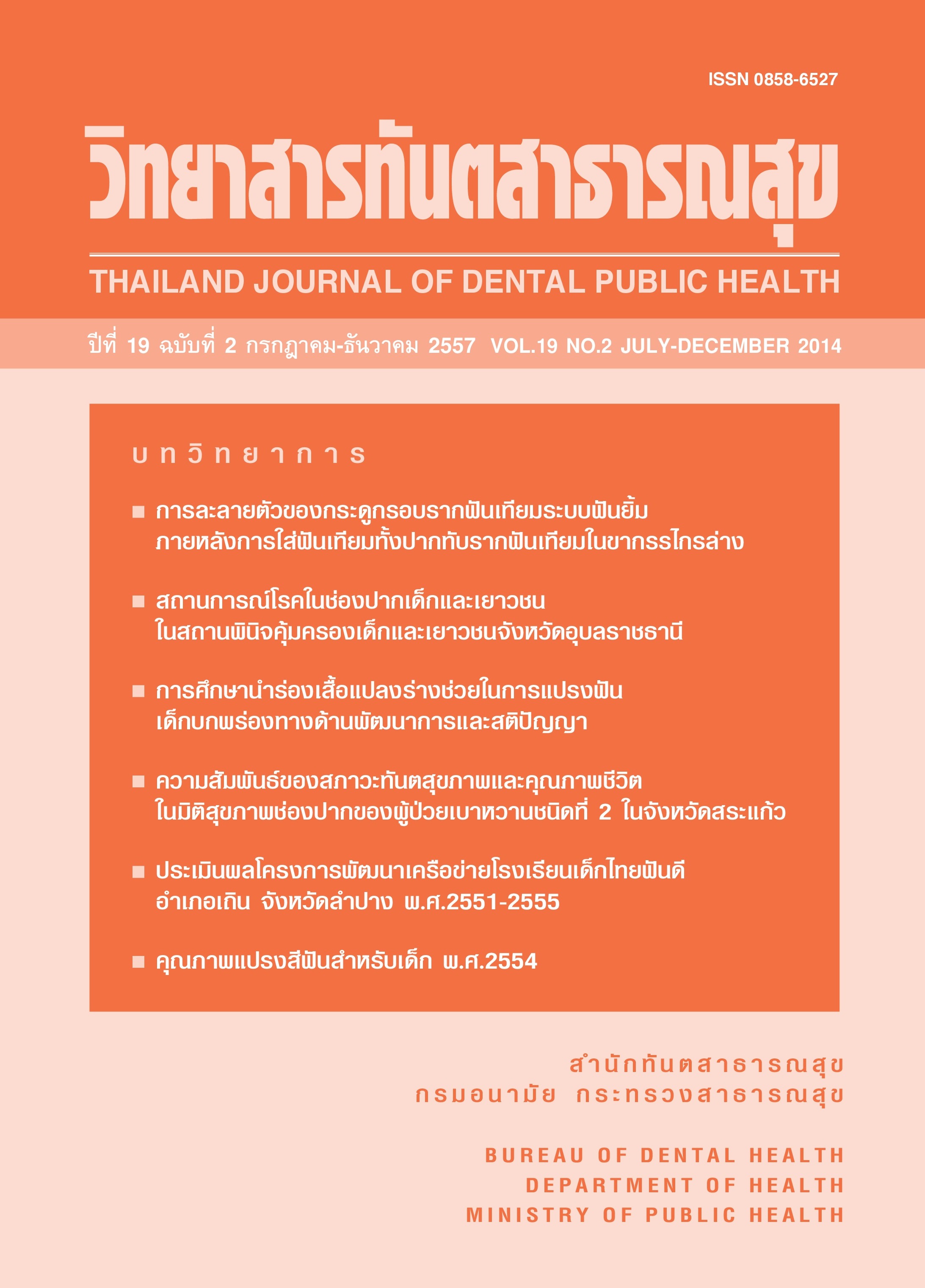The pilot study of the transforming shirt used for brushing intellectual and developmental disorder children’s teeth.
Main Article Content
Abstract
This pilot study developed the transforming shirts to limit movement of intellectual and developmental disorder children helping parents brushed their children’s teeth conveniently. The assessment was immediately done after the brushing. The samples were 29 parents which their 3-8 year children received preventive dental services at Rajanukul Institute and did not cooperate with their parents during toothbrushing, during April – June 2013.The transforming shirt is a shirt that has no sleeves, attached with belt, made of Tore cloth. There are 4 sizes which are XS, S M and L.The method of this study was interviewing the parents’ satisfaction after using the innovation from the assessment form developed for this study. The results showed that all of the parents were female, most of them aged in range between 31-40. 59.3 percent were mother. 78.6 percent of children were ranged in age between 3-5 years. 25 percent were diagnosed as Down syndrome. 21.4 percent were diagnosed as Autistic Spectrum Disorder. 85.7 percent were used XS
Downloads
Article Details
References
2. Nelson LP, Getzin A, Graham D, Zhou J, Wagle EM, McQuiston J, et al. Unmet dental needs and barriers to care for children with significant special health care needs. Pediatr Dent. 2011 Jan-Feb;33(1):29-36.
3. Bakry NS, Alaki SM. Risk factors associated with caries experience in children and adolescents with intellectual disabilities. J Clin Pediatr Dent. 2012 Spring;36(3):319-23.
4. Klein U, Nowak AJ. Autistic disorder: a review for the pediatric dentist. Pediatr Dent. 1998 Sep-Oct;20(5):312-7.
5. Kamen S, Skier J. Dental management of the autistic child. Spec Care Dentist. 1985 Jan-Feb;5(1):20-3.
6. Swallow JN. The dental management of autistic children. Br Dent J. 1969 Feb 4;126(3):128-31.
7. Guideline on periodicity of Examination, Preventive Dental Services, Anticipatory Guidance/Counseling, and Oral Treatment for Infants, Children, and Adolescents. Pediatr Dent. 2012-13;34(6):132-6.
8. Creeth JE, Gallagher A, Sowinski J, Bowman J, Barrett K, Lowe S, et al. The effect of brushing time and dentifrice on dental plaque removal in vivo. J Dent Hyg. 2009 Summer;83(3):111-6.
9. Guideline on behavior guidance for the pediatric dental patient. Pediatr Dent. 2012-13;34(6):12-3.
10. Connick C, Palat M, Pugliese S. The appropriate use of physical restraint: considerations. ASDC J Dent Child. 2000 Jul-Aug;67(4):256-62, 31.
11. Dougall A, Fiske J. Access to special care dentistry, part 3. Consent and capacity. Br Dent J. 2008 Jul 26;205(2):71-81.
12. Marshall J. Parental attitudes regarding behavior guidance of dental patients with autism. Pediatr Dent. 2008;30(5):400-7.
13. Oliveira AC, Paiva SM, Pordeus IA. Parental acceptance of restraint methods used for children with intellectual disabilities during dental care. Spec Care Dentist. 2007 Nov-Dec;27(6):222-6.
14. Salles PS TP, Oliveira CA, Souza IP, Portela MB, Castro GF. Dental needs and management of children with special health care needs according to type of disability. J Dent Child (Chic). 2012;79(3):165-9.
15. Frankel RI. The Papoose board and mothers' attitudes following its use. Pediatr Dent. 1991;13:284-8.


